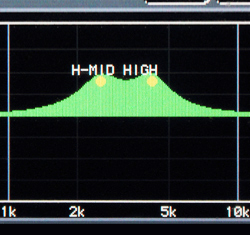I created a frog. It wasn’t intentional. Naturally, I’m not talking about a real frog, but look at the photo that opens this article. You’ll never read a mixing book that says, “Make the snare’s EQ curve look like a frog in water.” (If you do, stop immediately and back away.)
Seriously, when it comes to snare mixing, the last place (literally) you want to be is behind the mixer. With that in mind, here are three primary factors I’ve identified in getting a good snare drum sound.
1: The Drum
Snare drums don’t all sound the same, just like all acoustic guitars don’t sound the same. Even with a house drum kit, a drummer might bring his own snare because of it’s sound. Know that each snare has a unique sound. This is the baseline sound for the mix. Use the same mic and the same EQ settings with two different snares, and you’ll get two different results.
Consider the three different snares shown in Figure 1. Just by looking at them, you can almost hear the tonal differences. Material composite, drum size, drum head skin, all of these are factors. Even tuning makes a difference. Snares can be tuned to match whatever the drum tuner decides is to his liking. To generalize, there can be a low or high tuning (true for any drum).

Stand near the drum kit while the drummer plays the snare. This is the sound you’ll be mixing with – not against. Don’t try making it sound like something it’s not.
2: The Microphone(s)
A mic should be paired with an instrument and so it is with miking the snare. The Shure SM57 pairs great with a snare drum because of it’s polar pattern and frequency response.
I polled some techs and their pairings include the Telefunken M80, Heil PR22, Heil PR28, DPA 4099, and the Granelli Audio Labs G5790, a modified Shure SM57 designed for tight spots. And don’t think mic designs are the same (Figure 2).
Photos are nice but let’s get real – we need to look at specifics. They have different polar patterns, different sensitivity, and they don’t have to all be dynamic mics. For example, the Heil PR31 BW is a dynamic while the DPA 4099 is a condenser.
While several characteristics can make a big difference in how a mic treats sound, frequency response is a factor never to be overlooked. It alters the tonal characteristics of the snare drum. Take just one snare drum from above, like the Pearl Chad Smith Signature, and apply three different mics – the result is three different sounds. And we haven’t even touched the EQ.
For comparison, Figure 3 offers the frequency response charts for the SM57, PR31 BW, and 4099. (Note the charts with multiple lines are showing the differing frequency responses when not on-axis with the sound source).

In addition, snares can be (and are often) miked both over and under the drum. Here are a few combinations my tech friends recently sent me: Shure Beta57 over, Shure SM81 under; Audix i5s both over and under; Sennheiser MD421 over, Heil PR31 BW under; Audix i5 over, SM57 under; Heil PR22 over, Sennheiser e904 under.





















